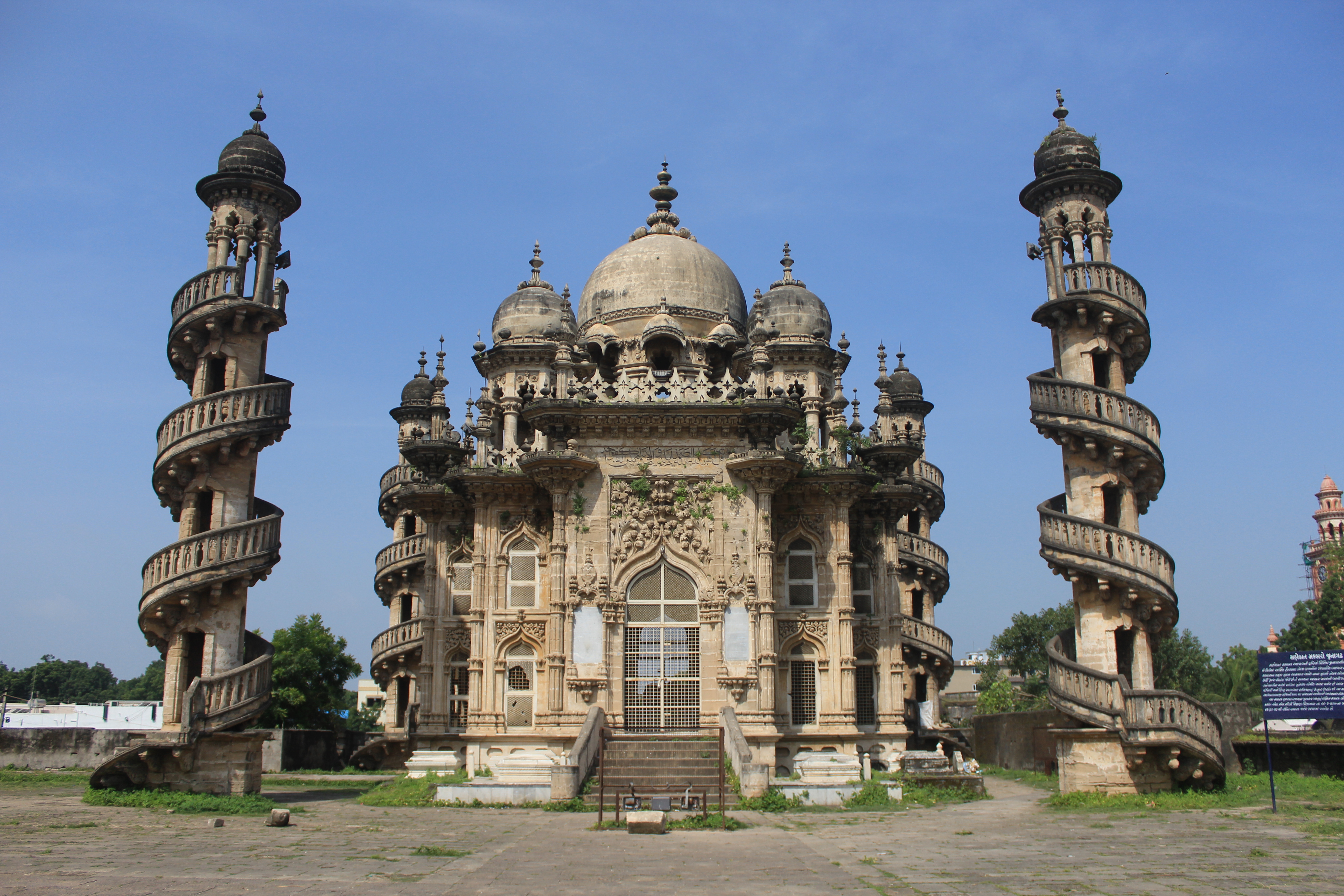Mahabat Maqbara on:
[Wikipedia]
[Google]
[Amazon]
Mahabat Maqbara and Bahauddin Maqbra are
 The adjacent mausoleum in north was constructed by Mahabat Khan II's
The adjacent mausoleum in north was constructed by Mahabat Khan II's
 These mausoleums are known for amalgamation of Indo-Islamic styles (mainly
These mausoleums are known for amalgamation of Indo-Islamic styles (mainly
mausoleum
A mausoleum is an external free-standing building constructed as a monument enclosing the interment space or burial chamber of a deceased person or people. A mausoleum without the person's remains is called a cenotaph. A mausoleum may be consid ...
s in Junagadh, Gujarat, India. They were completed in 1892 and 1896 respectively and are dedicated to Mahabat Khan II, the Nawab
Nawab (Balochi language, Balochi: نواب; ar, نواب;
bn, নবাব/নওয়াব;
hi, नवाब;
Punjabi language, Punjabi : ਨਵਾਬ;
Persian language, Persian,
Punjabi language, Punjabi ,
Sindhi language, Sindhi,
Urd ...
of Junagadh State, and his minister Bahauddin Hussain Bhar respectively.
History
TheNawab
Nawab (Balochi language, Balochi: نواب; ar, نواب;
bn, নবাব/নওয়াব;
hi, नवाब;
Punjabi language, Punjabi : ਨਵਾਬ;
Persian language, Persian,
Punjabi language, Punjabi ,
Sindhi language, Sindhi,
Urd ...
s of Babi dynasty ruled the erstwhile Junagadh State. The construction of the Mahabat Maqbara was started in 1878 by Nawab Mahabat Khan II (1851–82) and ended in 1892 during the reign of Nawab Bahadur Khan III (1882–92). It houses grave of Mahabat Khan II. It is a State Protected Monument under Gujarat Ancient Monuments and Archaeological Sites and Remains Act, 1965.
 The adjacent mausoleum in north was constructed by Mahabat Khan II's
The adjacent mausoleum in north was constructed by Mahabat Khan II's Vizier
A vizier (; ar, وزير, wazīr; fa, وزیر, vazīr), or wazir, is a high-ranking political advisor or minister in the near east. The Abbasid caliphs gave the title ''wazir'' to a minister formerly called '' katib'' (secretary), who was ...
(minister) Sheikh Bahauddin Hussain Bhar with his own funds during 1891–1896. It is known as the Bahauddin Maqbara or Vazir's Maqbara.
Architecture
 These mausoleums are known for amalgamation of Indo-Islamic styles (mainly
These mausoleums are known for amalgamation of Indo-Islamic styles (mainly Gujarat Sultanate
The Gujarat Sultanate (or the Sultanate of Guzerat), was a Medieval Indian kingdom established in the early 15th century in Western India, primarily in the present-day state of Gujarat, India. The dynasty was founded by Sultan Zafar Khan Mu ...
and Mughal) with considerable European
European, or Europeans, or Europeneans, may refer to:
In general
* ''European'', an adjective referring to something of, from, or related to Europe
** Ethnic groups in Europe
** Demographics of Europe
** European cuisine, the cuisines of Europe ...
(Gothic
Gothic or Gothics may refer to:
People and languages
*Goths or Gothic people, the ethnonym of a group of East Germanic tribes
**Gothic language, an extinct East Germanic language spoken by the Goths
**Crimean Gothic, the Gothic language spoken b ...
) influence.
These mausoleums have the carvings on its inner and outer façades and arches with yellowish light brown exterior. They have onion-shaped domes, French windows, sculptures, marble tracery work, marble columns, marble jali
A ''jali'' or jaali (''jālī'', meaning "net") is the term for a perforated stone or latticed screen, usually with an ornamental pattern constructed through the use of calligraphy, geometry or natural patterns. This form of architectural d ...
s and silver doorways. The minarets on four sides of one of these mausoleums has winding staircases around them.
The Jama Mosque is located nearby with similar architectural style.
See also
*Uparkot Fort
Uparkot is a fort located in east side of Junagadh, Gujarat, India.
History
A fort and town was established at the foothills of Girnar hill during reign of the Maurya Empire and continued to be used during Gupta period, but it lost its importance ...
*Uparkot Caves
Uparkot caves, also Uperkot caves, are ancient man-made caverns. The caves are a part of the Junagadh Buddhist Cave Groups situated in the eastern part of Junagadh of the Indian state of Gujarat.
Caves
These caves located at Uperkot beyond the ...
*Jumma Masjid, Uparkot
Jumma Masjid or Jama Masjid is a mosque in Uparkot Fort in Junagadh, Gujarat, India. The mosque was built in 15th century by converting a temple or a palace now identified as Ranakdevi Mahal by local people. There is a controversy surrounding the ...
*Junagadh rock inscription of Rudradaman
The Junagadh rock inscription of Rudradaman, also known as the Girnar Rock inscription of Rudradaman, is a Sanskrit prose inscribed on a rock by the Western Satraps ruler Rudradaman I. It is located near Girnar hill near Junagadh, Gujarat, India ...
References
{{Reflist Royal monuments Junagadh Buildings and structures in Gujarat Mausoleums in Gujarat Tourist attractions in Junagadh district Indo-Islamic architecture Gothic Revival architecture in India